I’ve been a convert of KTM’s two-wheeled General Lee since the original Super Duke appeared back in 2003. The all-sliding, all-drifting, front-wheel lofting devils have had me wheeling my well-intentioned streetfighter projects to the back of the shed for nearly two decades now. And when the Austrians released the first of the 1290 versions in 2013, aptly dubbed ‘the Beast’, a little bit of wee come out. That was followed four years later by the Beast 2.0, for which I was almost willing to resort to fisticuffs rather than give it back following our nakedbike comparo last year (AMCN Vol 69 No 05).
The Beast 2.0, is a hoot to ride, there’s very little to complain about. Its stonking, knee trembler of an engine is capable of inducing evil hilarity whenever you give it a handful and I’m yet to meet a person who has actually ridden a 1290 Super Duke and didn’t like it. Sure, it’s not perfect and it’s not for everyone, but man, if you have a pulse and you aren’t mildly aroused by that V-twin engine then perhaps knitting is more your pace.
Now, with not a whole heap of water under the bridge, you may be thinking that the 2020 version might be a selection of well-meaning but superficial updates to spur on a few sales. But nup; the Austrians aren’t resting on their laurels and have fronted up with a fresh new Super Duke R that KTM claims is 90 percent new.
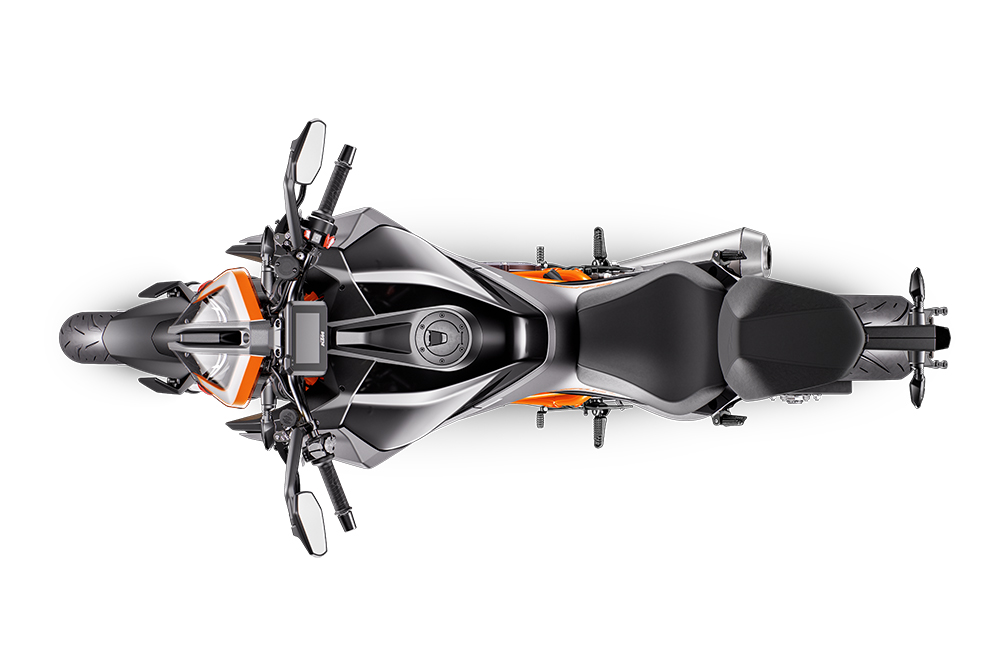
Slashing weight and improving handling was the brief for the latest bike and project leader Hermann Sporn and his team set out to reduce each new component by around five percent over the outgoing one. Sporn has worked on the Super Duke since joining the marque back in 2005 and there’s not a lot the lanky Austrian can’t tell you about the Beast or its forebears.
The outrageously fun and charismatic engine has received a bit of a massage, not that many mere mortals would have been crying out for more sting from the burly 1301cc V-twin as it was. Nonetheless, with a bit of love, the donk gains two extra kW, now oozing 132kW (177hp) at 9500rpm, a bit of twirling of some magic torque curve dials has the 75-degree eight-valve twin slapping down 140Nm of torque at 8000rpm, 100 of which are brought to bear by just 3500rpm.
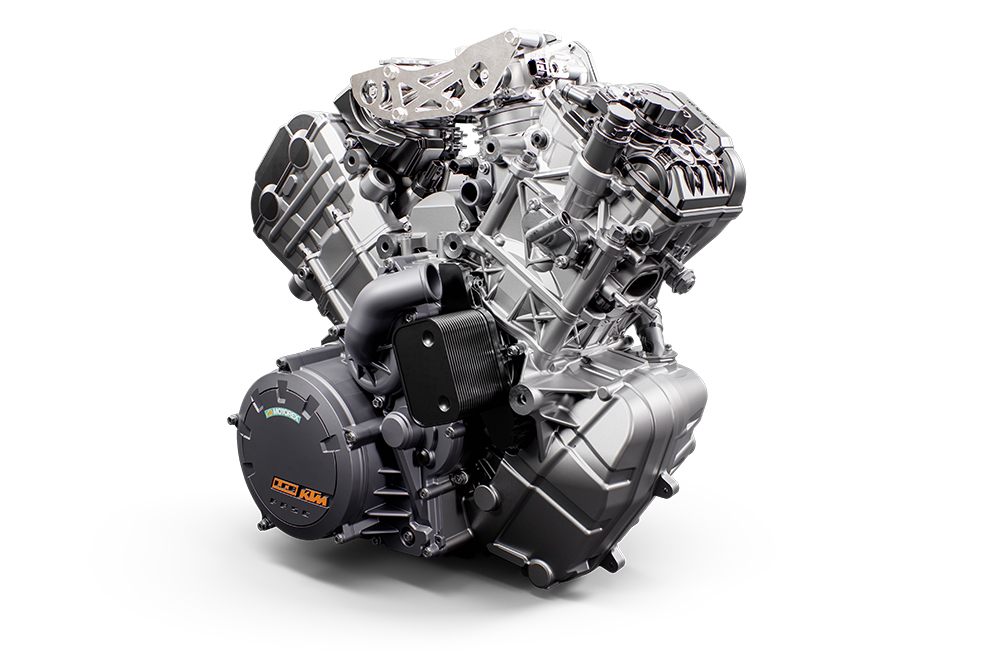
The gains in performance are delivered via a redesigned singular air intake set within the revised headlight, which feeds a larger 10-litre airbox and new top-feeder injectors said to improve the delivery of the fuel and air mixture. And modifications to the LC8 powerplant, such as redesigned crankcases and aluminium oil lines, are claimed to reduce engine weight by almost a kilo.
A larger-diameter stainless exhaust system now runs dual catalytic converters rather than the older single-cat unit, and KTM engineers have still managed to shave a kilogram off the weight compared to the old system.
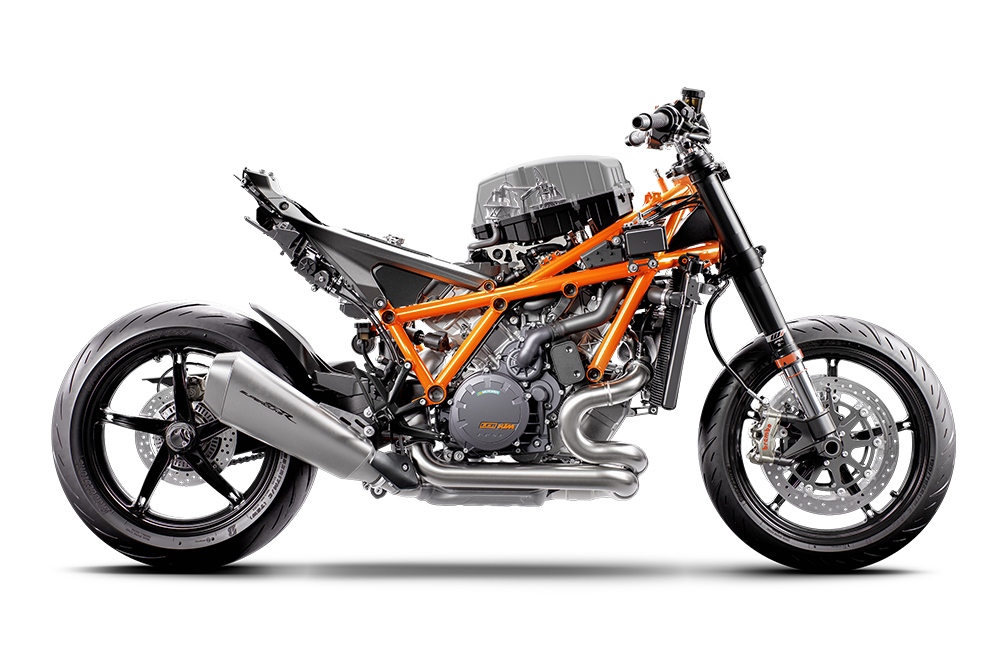
On the electronics front, there’s the same three riding modes as before (Rain, Street, Sport) with the necessary reconfigurations to the software to complement the updated bike.
The four-axis IMU of the old bike has been replaced with a six-axis affair talking to both the traction control and ABS systems for more precise intervention at any lean angle, all aimed at keeping you out of the shit when the excitement gets too much.
The chassis is now lighter and stiffer, which is aimed at providing better front-end feedback to the rider, while the tubular-steel subframe has been replaced by an updated alloy and composite material unit that weighs just 900 grams.
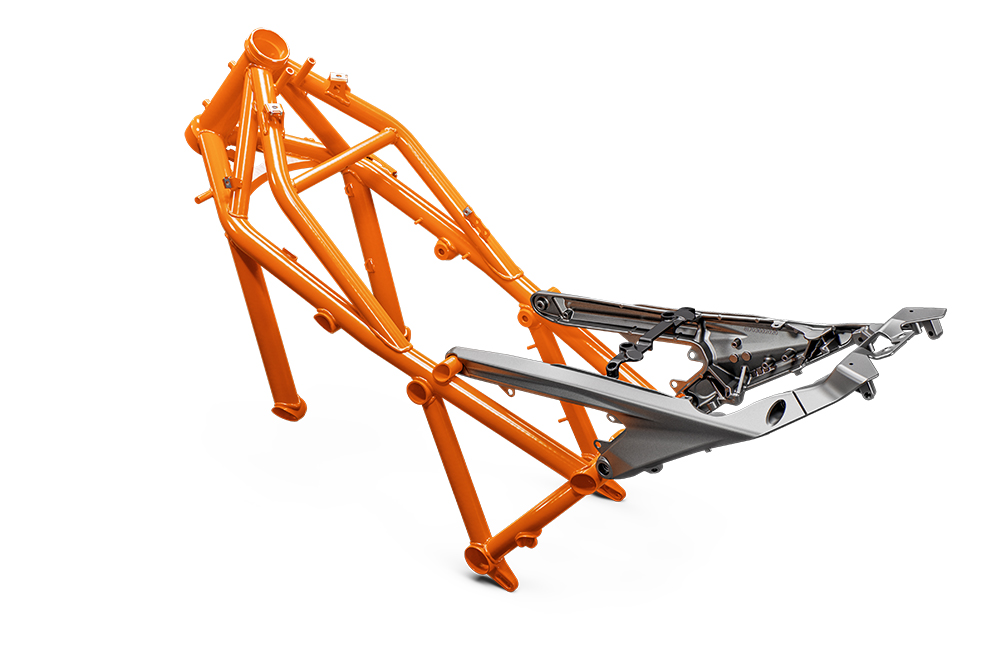
A new WP Apex rear shock now attaches to the swingarm – which is also lighter and more rigid – via a linkage system rather than the direct mount system of old, with front suspension duties handled by WP’s 48mm open cartridge Apex fork.
Now employing Brembo’s class-leading Stylema calipers, which are almost 100 grams lighter and even more powerful than the already excellent calipers on the outgoing model, new wheels (yes, lighter and stiffer) and revised ergonomics also feature in the exhaustive list of updates that abound the new Super Duke. The revised ergonomics include a new seat, lower-set handlebars and a new and reshaped tank and shrouds, all of which add up to a more aggressive riding stance. Apt really, given the more aggressive machine on offer for 2020.
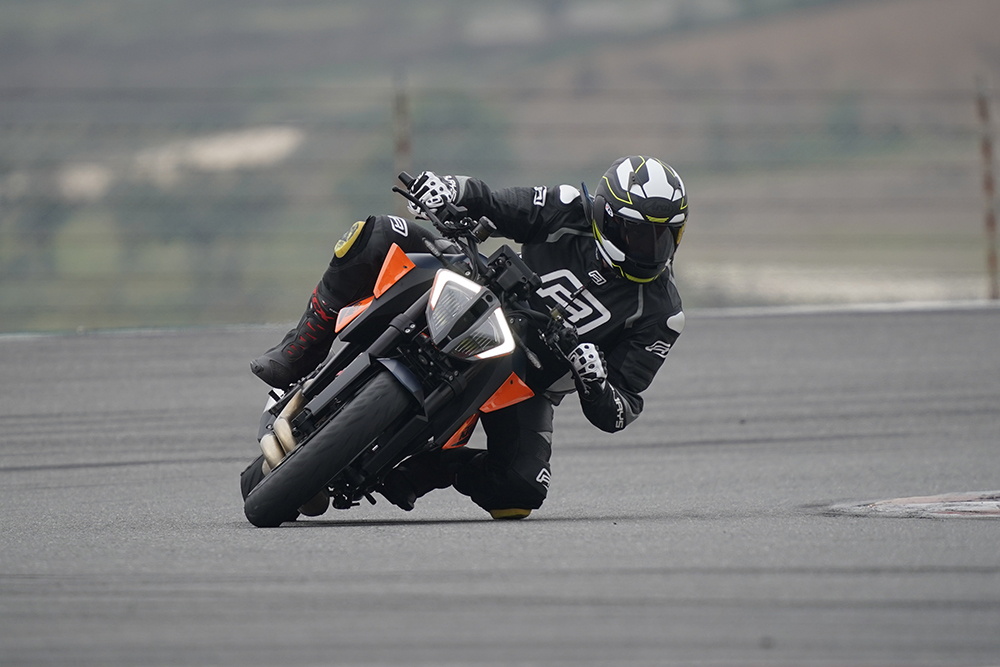
KTM claims the result of all the dieting advice is a smidgen under 200kg with fluids but no fuel. So if the 16-litre tank is full and ready to ride, the realistic weight of the 2020 KTM 1290 Super Duke is somewhere around the 210kg mark.
My chance to sample the new 1290 came at Portugal’s 4.7km Portimao Circuit. Host to a round of the WorldSBK Championship, the circuit is perfect for putting a street bike with copious sporting potential through its paces.
Highly technical, it’s an amalgamation of mostly blind corners, and it means riders new to the layout arrive into corners pointing in directions not conducive to quick lap times. It leaves riders like me having to rely on a more point and shoot, hope for the best and learn the track as quickly as possible style. This is very much like the conditions you find fanging down some back road you’d never been down before, just much, much quicker. So lucky for me, this is exactly the sort of riding the Beast 3.0 excels at.
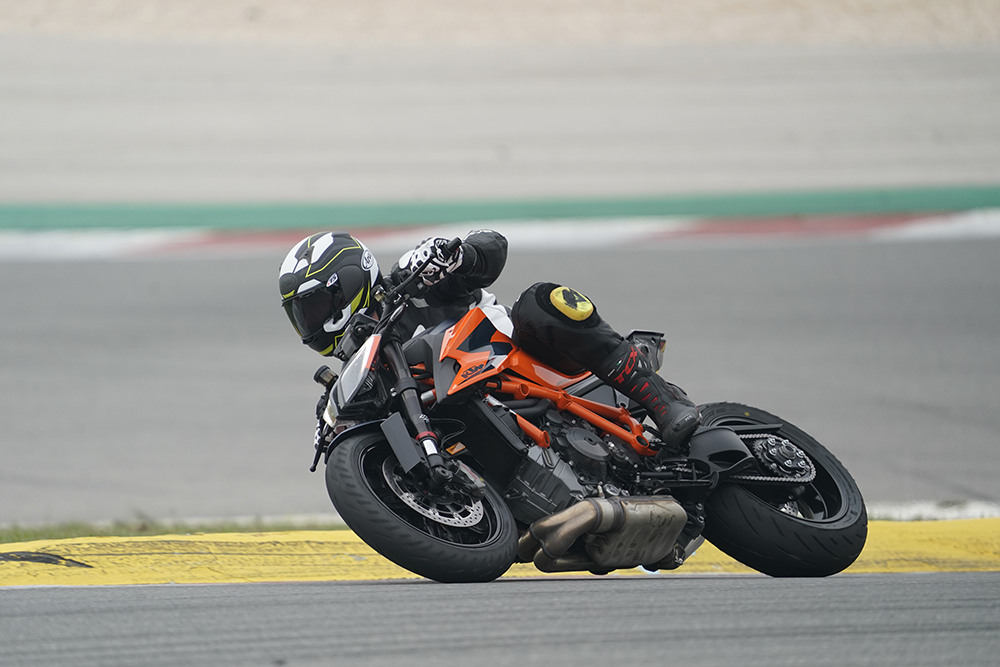
We also headed up into the hills surrounding the Portimao Circuit and out to the coast. But because of the attributes of the circuit, so-called normal road conditions didn’t reveal much that the circuit didn’t bring into sharp focus with its higher speeds. Actually, there were three things; roads in Portugal are as smooth as a 17-year-old’s pick-up lines, so they – the shit roads, not the pick-up lines – allowed the flash new WP suspension to shine over some really rough surfaces. On this front, it was perfect, whether you’re travelling at slow speeds or flirting with being led away in handcuffs, the Apex suspension took the reins and it never ever looked like getting ugly. This was complemented by a smoother throttle response too, most noticeably in Street mode, one of very few complaints I had about the outgoing model.
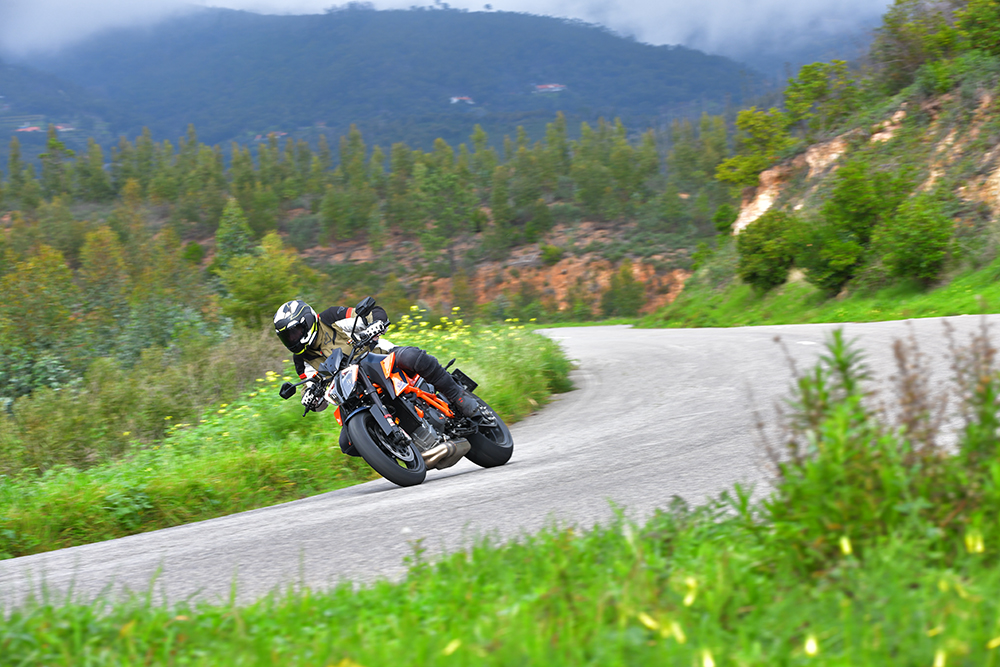
The second area highlighted by the road ride was the new left-hand switch block and, in particular, the indicator switch. The new switch block looks neat and it’s well laid out, but it’s a tad cluttered for my big meat hooks, and I gave a friendly toot on a few occasions when I should have been cancelling an indicator. It’s something you’d get used to after spending more time with the bike (or if you have smaller hands).
The last thing is the seat. For such an intense and unhinged bike, the 2.0 was very comfortable and the 3.0 is better again. The fatigue from holding on to prevent being blown off the thing at high speed will get you before a sore arse will. While on the subject of time in the saddle, the airbox’s capacity increase has resulted in the fuel tank being reduced from 18 litres to 16. We didn’t have the opportunity to test the range and KTM doesn’t supply consumption figures, so we’ll have to wait to see what the verdict is on range from the smaller tank when we test it in Oz.
The stiffening up process rendered on the chassis has improved feedback from the front end. The 2.0 wasn’t bad, it just didn’t offer as much front-end feedback as we’d like and was bested by BMW’s S 1000 R in our nakedbike shootout.
Not being familiar with the Portuguese track had me arriving in corners unprepared and, at times, carrying too much speed. It meant I had to trust the front and that was rewarded by the 3.0’s ability to turn in quickly, hold a line and provide a real sense of what the front Bridgestone was up too.
The 2.0 had a tendency for the arse end to squat under acceleration, taking weight off front end and pushing the Duke wide on the exit of a corner. KTM listened to this feedback, and it was a big focus of the redesign. I’ll admit that it was never a problem that reared its head for me, but I never had the opportunity to sample the 2.0 in a track environment either, and if the likes of three-time Pikes Peak winner Chris Fillmore and GP legend Jeremy McWilliams, both of whom helped develop the 2020 model say it is so, then I’m inclined to agree.
Brembo’s swish Stylema monobloc calipers lift the KTM’s front end braking game. They are incredibly powerful and easily have the tail swinging in the breeze with liberal use but, at the same time, offering superb feel.

Suspension performance has been improved with WP’s Apex spring bits. The open cartridge fork and longer rear shock have a greater oil capacity that aids cooling when things get steamy, providing more consistent performance. The rear preload is now adjusted via an external knob, so tool-less preload settings are easy when you hit the track or if you’re dragging a passenger or luggage around. Three very different applications, but the Beast can excel at all three.
KTM claims that a bronze and copper coating on the shift forks provides a smoother and lighter shift action through the six-speed ’box. The shift seemed less agricultural when you’re powering up or down through the gearbox using the optional quickshifter+ fitted to the test bike.
This slightly notchy feeling wasn’t really an issue on the 2.0 that didn’t have the Quickshifter fitted. And on that topic is my biggest gripe with the new Super Duke. Quickshifter+ is still an optional extra. Really? Pricing hasn’t been set for the 3.0 but it’s a safe bet that it’ll be closer to $30K than 20. Yamaha’s MT-09 comes equipped with a quickshifter as standard. Not really good enough in 2020, KTM.
The electronics package on the new Duke has been refined rather than revolutionised, with the exception of the flash new six-axis IMU. The new IMU picks up the usual feedback from the ABS and Traction Control system, but it now has the ability to sense discrepancies between the amount of slide between the front and rear wheels – or, to you and me, sensing the amount of drift. Backing it in, for example, in which case the IMU would detect the difference in position and speed at both ends and will attempt to rectify the situation.
The TFT display has come in for a small upgrade. The menu system is easier to use, and menu selection via the slightly cluttered left-hand switch block is easier than the old set-up. Flicking through the three standard ride modes can be done on the fly. For those looking for a little more customisation in their settings, KTM offers two optional modes (Track and Performance). The right-hand switch block now features two programmable toggles and the cruise control can now be easily adjusted with new paddle switches on the left switch block.
The previously mentioned ergonomics gives the bike a fresher look, while still remaining very comfortable for my 186cm frame. Being a naked, the wind will zap your energy, especially if you have a similar surface area to what I have. Hitting 260km/h on the main straight of Portimao has you holding on with all your might, believe me. KTM offers a small screen from its crazy-large Powerparts catalogue, and while it looks small enough to be useless, it’s surprisingly quite effective, and I’d be bunging one on for sure.
I loved the Beast 2.0. And the new Super Duke had big shoes to fill. Expectation was sky high but the biggest hazard you’ll face is the never-ending risk of losing your licence.
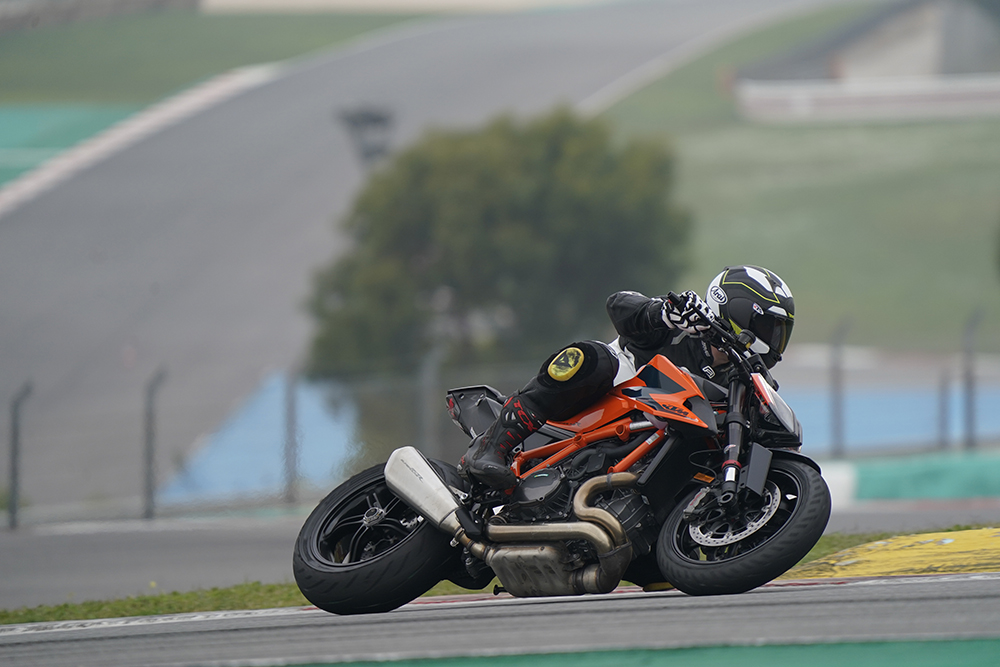
TEST: PETE VORST PHOTOGRAPHY KISKA GMBH & SCHEDL R











